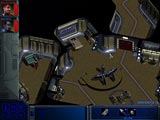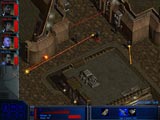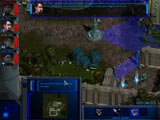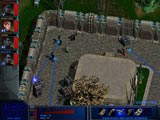 Star Trek. The very
name conjures up warm memories; late nights before the television watching episodes
I’d recorded from the week before, midnight reruns, warm blankets and popcorn. So when a squad-orientated tactical combat game
based in the Next Generation universe arrived, I had little choice but to take a look at
the box. Add in the Borg and multi-player
support and I could do nothing but carry it from the office, down the steps, through the
door, and all the way to my home computer. It
was only after I had launched the game and played for a few minutes that I realized that
Activision, Away Team’s publisher, had run up against and not quite overcome two
fundamental truisms. First: when making a
game in a genre that already contains some really good games, yours had better be really
good too. Second: television shows
traditionally make very poor computer games.
That considered, ActiVision managed to do a pretty decent job, and this
real-time tactical combat game delivered a relatively engaging experience based in a
universe adored by many, with a wide enough variety of unique features to make it worth a
look. Unfortunately, while ST: Away Team does
hold its own in a world of theme-based combat games, it misses many of those key features
that normally define a standout product. Star Trek. The very
name conjures up warm memories; late nights before the television watching episodes
I’d recorded from the week before, midnight reruns, warm blankets and popcorn. So when a squad-orientated tactical combat game
based in the Next Generation universe arrived, I had little choice but to take a look at
the box. Add in the Borg and multi-player
support and I could do nothing but carry it from the office, down the steps, through the
door, and all the way to my home computer. It
was only after I had launched the game and played for a few minutes that I realized that
Activision, Away Team’s publisher, had run up against and not quite overcome two
fundamental truisms. First: when making a
game in a genre that already contains some really good games, yours had better be really
good too. Second: television shows
traditionally make very poor computer games.
That considered, ActiVision managed to do a pretty decent job, and this
real-time tactical combat game delivered a relatively engaging experience based in a
universe adored by many, with a wide enough variety of unique features to make it worth a
look. Unfortunately, while ST: Away Team does
hold its own in a world of theme-based combat games, it misses many of those key features
that normally define a standout product. Star Trek:
Away Team is played from a zoomable third-person isometric perspective in much the same
style of the Jagged Alliance or Fallout games. You
are placed in control of between four to six members of a Special Forces branch of the
Federation. That number varies from mission
to mission, as does the goal of each level. However,
while on the later missions you are allowed to select the members of your away team, there
is little variation between the officers from which you can choose. Indeed, despite having several options to select
from, you often reuse the same characters for every mission. This would be an understandable team selection
design were your roster to shrink, but since the death of any of your characters
automatically aborts your mission as a failure, the entire game is played without the loss
of any of your team. As it stands the ability
to select the makeup of your away team is a nice, but basically unutilized feature. Star Trek:
Away Team is played from a zoomable third-person isometric perspective in much the same
style of the Jagged Alliance or Fallout games. You
are placed in control of between four to six members of a Special Forces branch of the
Federation. That number varies from mission
to mission, as does the goal of each level. However,
while on the later missions you are allowed to select the members of your away team, there
is little variation between the officers from which you can choose. Indeed, despite having several options to select
from, you often reuse the same characters for every mission. This would be an understandable team selection
design were your roster to shrink, but since the death of any of your characters
automatically aborts your mission as a failure, the entire game is played without the loss
of any of your team. As it stands the ability
to select the makeup of your away team is a nice, but basically unutilized feature.
Star Trek: Away Team contains
a wash of both positive and negative aspects.
Many features are improvements on existing combat games. Additions like the Vision and Sound Cones, which
show a guard’s line of sight and range of hearing, go a long way to eliminating a lot
of the frustration that plagues much of Away Team’s current competition. It is surprising, then, that while many
excellent features made it into the game, many equally obvious flaws appear to drag it
down. These range from an idiotic enemy AI to
the inability of your characters to throw an item over any object. This
is painfully obvious the first time a grenade bounces back onto you team after colliding
with one of the invisible walls present over every obstacle. One would think that the Special Forces of the
future would be capable of throwing an object the size of a baseball over a barrel that
barely reaches to their waist.
 Activision’s decision to make the game real-time worked
surprisingly smoothly. The player can pause
the action at any point by pressing Enter, and then use the frozen time to distribute
orders to your men (and women) at will. The
style of play can vary greatly depending on how often you use the pause key to micromanage
your men. Rarely pausing leads to
fast-clicking action oriented combat, while pausing often leads too much more detailed
tactical planning. The tactical strengths of
Away Team quickly stall though, when it becomes evident that the artificial intelligence
system of the game is… well… stupid. For all given purposes the enemy’s actions are limited to either shooting a target,
running after it, or forgetting about it and returning to an inactive state as soon as it
is out of sight. Often times the most
effective strategy is simply to let yourself be seen by a single guard, and to then
retreat to a point where your entire team can focus their phaser fire on him. I’m not saying that doing so isn’t any
fun, it’s just more arcade-like than strategic. Activision’s decision to make the game real-time worked
surprisingly smoothly. The player can pause
the action at any point by pressing Enter, and then use the frozen time to distribute
orders to your men (and women) at will. The
style of play can vary greatly depending on how often you use the pause key to micromanage
your men. Rarely pausing leads to
fast-clicking action oriented combat, while pausing often leads too much more detailed
tactical planning. The tactical strengths of
Away Team quickly stall though, when it becomes evident that the artificial intelligence
system of the game is… well… stupid. For all given purposes the enemy’s actions are limited to either shooting a target,
running after it, or forgetting about it and returning to an inactive state as soon as it
is out of sight. Often times the most
effective strategy is simply to let yourself be seen by a single guard, and to then
retreat to a point where your entire team can focus their phaser fire on him. I’m not saying that doing so isn’t any
fun, it’s just more arcade-like than strategic.
This combined with the fact
that there is no Fog of War (all enemies and points of interest are highlighted on a
pop-up map) guarantees that the player will always be better prepared for an encounter
than the enemy. If it were not for the fact
that your own team members have no independent intelligence of their own, seeming to lack
any initiative to move when fired upon or to fire back without you actively telling them
to, the combat would be overly easy. As the
game progresses the objectives change, making it more difficult as infiltration through
stealth becomes more important. With the
miserable artificial intelligence of Away Team, this is less difficult to do than one
might expect, as the enemy patrols always follow set patterns, never raise an alarm to the
other guards (they merely follow after you to the slaughter), and have unreasonably short
memories.
 That aside, it’s still a Star Trek game, isn’t
it? Well, yes and no. Most of the elements are indeed from Star Trek
(Klingons, Borg, etc.), and some characters from the Next Generation series do make
appearances throughout the game (Data and Worf). At
the same time, part of the enchantment of the Star Trek world is its ability to create
strange and fantastic scenarios. Star Trek:
Away Team plays on this little. For example,
the weapons available to your team never change. While
you are able to upgrade the weapons you start with (you couldn’t legitimately have a
Star Trek combat game without a phaser), you never acquire new or exotic weapons. In a universe rich with strange technology, races,
and cultures, the ActiVision team never fully took advantage of the creative leeway they
possessed (I would have loved to see Q make an appearance, for example). While you did see this some (there are times when
you utilize items found while on missions) I think there was a great opportunity missed by
the programming team. That aside, it’s still a Star Trek game, isn’t
it? Well, yes and no. Most of the elements are indeed from Star Trek
(Klingons, Borg, etc.), and some characters from the Next Generation series do make
appearances throughout the game (Data and Worf). At
the same time, part of the enchantment of the Star Trek world is its ability to create
strange and fantastic scenarios. Star Trek:
Away Team plays on this little. For example,
the weapons available to your team never change. While
you are able to upgrade the weapons you start with (you couldn’t legitimately have a
Star Trek combat game without a phaser), you never acquire new or exotic weapons. In a universe rich with strange technology, races,
and cultures, the ActiVision team never fully took advantage of the creative leeway they
possessed (I would have loved to see Q make an appearance, for example). While you did see this some (there are times when
you utilize items found while on missions) I think there was a great opportunity missed by
the programming team.
 But
all that aside, there still remains the multi-player aspect of the game. ST: Away Team is
playable over a local area network with up to two players in co-operative mode (there is
no deathmatch or competitive combat). Only
one CD is required to do this, which is a trend I’m glad to see is still holding
strong amongst game producers (don’t laugh, there was a time it wasn’t so). The members of the Away Team are divided between
the two players during the actual combat (meaning that no one character is controlled by a
designated player- control of the characters is traded often). Sadly, the multi-player experience offers little,
for several very distinct reasons. The most
obvious of these are the limits of the map and level designs. Star Trek: Away Team is completely linear. There are no additional maps or missions available
for multi-player games. Nor is there any
obvious method for building, developing, or expanding the missions and maps at a future
time. The objectives are the same, as well as
briefings, enemy placement, and tactics, as those in the single player game. Since a map isn’t available in multi-player
until it has been reached in the single player mode, every mission seen in the
multi-player games has been played before by at least one of the two gamers. Since the AI is unable to deviate from its rather
limited programming, multi-player offers little new to the players. So what about different strategies? Shouldn’t two brains working together be
better equipped to defeat a level than one? The
answer again is yes and no. Since there are
no levels designed for multiple players, there are no challenges that can’b be
overcome with the tactics originally used to defeat them in the single player game. The maps in which the players must avoid detection
often leave only one pathway open to a goal, clogging all others with many obstacles and
guards. As a consequence, the advantage of
having two squads that can operate independently is lost as they are corralled into using
the same doors and corridor from start to finish. Due
to the structure of the AI and the linear level design, the game soon becomes repetitive.
The inability to lose a single team member without the mission ending is also a problem. A single screw-up by one player often results in
forcing the other player to restart as well, making the game play limited by the skills of
the weakest gamer. Even when two players are
equally skilled, communication within the game is too slow to allow efficient planning. But
all that aside, there still remains the multi-player aspect of the game. ST: Away Team is
playable over a local area network with up to two players in co-operative mode (there is
no deathmatch or competitive combat). Only
one CD is required to do this, which is a trend I’m glad to see is still holding
strong amongst game producers (don’t laugh, there was a time it wasn’t so). The members of the Away Team are divided between
the two players during the actual combat (meaning that no one character is controlled by a
designated player- control of the characters is traded often). Sadly, the multi-player experience offers little,
for several very distinct reasons. The most
obvious of these are the limits of the map and level designs. Star Trek: Away Team is completely linear. There are no additional maps or missions available
for multi-player games. Nor is there any
obvious method for building, developing, or expanding the missions and maps at a future
time. The objectives are the same, as well as
briefings, enemy placement, and tactics, as those in the single player game. Since a map isn’t available in multi-player
until it has been reached in the single player mode, every mission seen in the
multi-player games has been played before by at least one of the two gamers. Since the AI is unable to deviate from its rather
limited programming, multi-player offers little new to the players. So what about different strategies? Shouldn’t two brains working together be
better equipped to defeat a level than one? The
answer again is yes and no. Since there are
no levels designed for multiple players, there are no challenges that can’b be
overcome with the tactics originally used to defeat them in the single player game. The maps in which the players must avoid detection
often leave only one pathway open to a goal, clogging all others with many obstacles and
guards. As a consequence, the advantage of
having two squads that can operate independently is lost as they are corralled into using
the same doors and corridor from start to finish. Due
to the structure of the AI and the linear level design, the game soon becomes repetitive.
The inability to lose a single team member without the mission ending is also a problem. A single screw-up by one player often results in
forcing the other player to restart as well, making the game play limited by the skills of
the weakest gamer. Even when two players are
equally skilled, communication within the game is too slow to allow efficient planning.
In short, while Star Trek: Away Team is not without its merits and innovations, it lacks a
great many of the elements that make a good strategy game.
Without an intelligent AI system, extensive and exciting weapons, or some
way to modify the missions for replay value, Away Team quickly loses most of its initial
appeal. Aside from the fact that it is based
in a universe I have missed since the ending of the Next Generation series, Star Trek:
Away Team holds little for the average strategy gamer that cannot be better found in many
of the other squad-based tactical games on the market
Aaron
Stanton |
